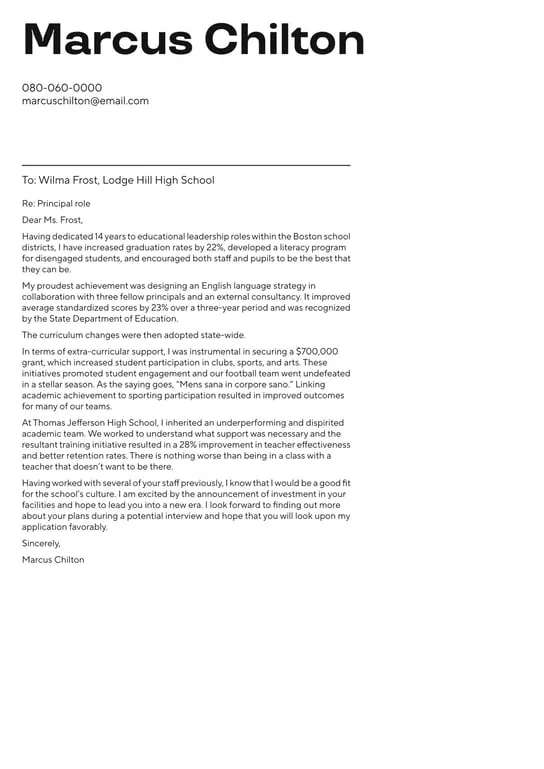Why a Cover Letter is Crucial for Principals
A well-crafted cover letter is your first opportunity to make a strong impression on a school principal. It goes beyond the information presented in your resume, allowing you to showcase your personality, passion for education, and understanding of the specific needs of the school. In the competitive field of education, a compelling cover letter can significantly increase your chances of landing an interview and ultimately securing the position. It demonstrates your communication skills, attention to detail, and genuine interest in the school and its students. Principals often use cover letters to assess a candidate’s writing ability, critical thinking skills, and ability to articulate their qualifications effectively. A cover letter provides a platform to highlight your unique strengths and how they align with the school’s values and goals.
Highlighting Your Key Skills
Identify the key skills most relevant to a principal role and emphasize them in your cover letter. These may include leadership, communication, problem-solving, conflict resolution, curriculum development, and financial management. Provide specific examples that demonstrate how you have utilized these skills in previous roles. For instance, if you are highlighting your leadership skills, describe a time when you successfully led a team to achieve a specific goal, such as improving student test scores or implementing a new school-wide initiative. Back up your claims with data and quantifiable results, such as an increase in student engagement or a reduction in disciplinary incidents. Tailor the skills you highlight to match the requirements and priorities outlined in the job description. Showcasing the right skills at the right time can capture the attention of the principal, leading you closer to an interview.
Showcasing Educational Leadership Experience
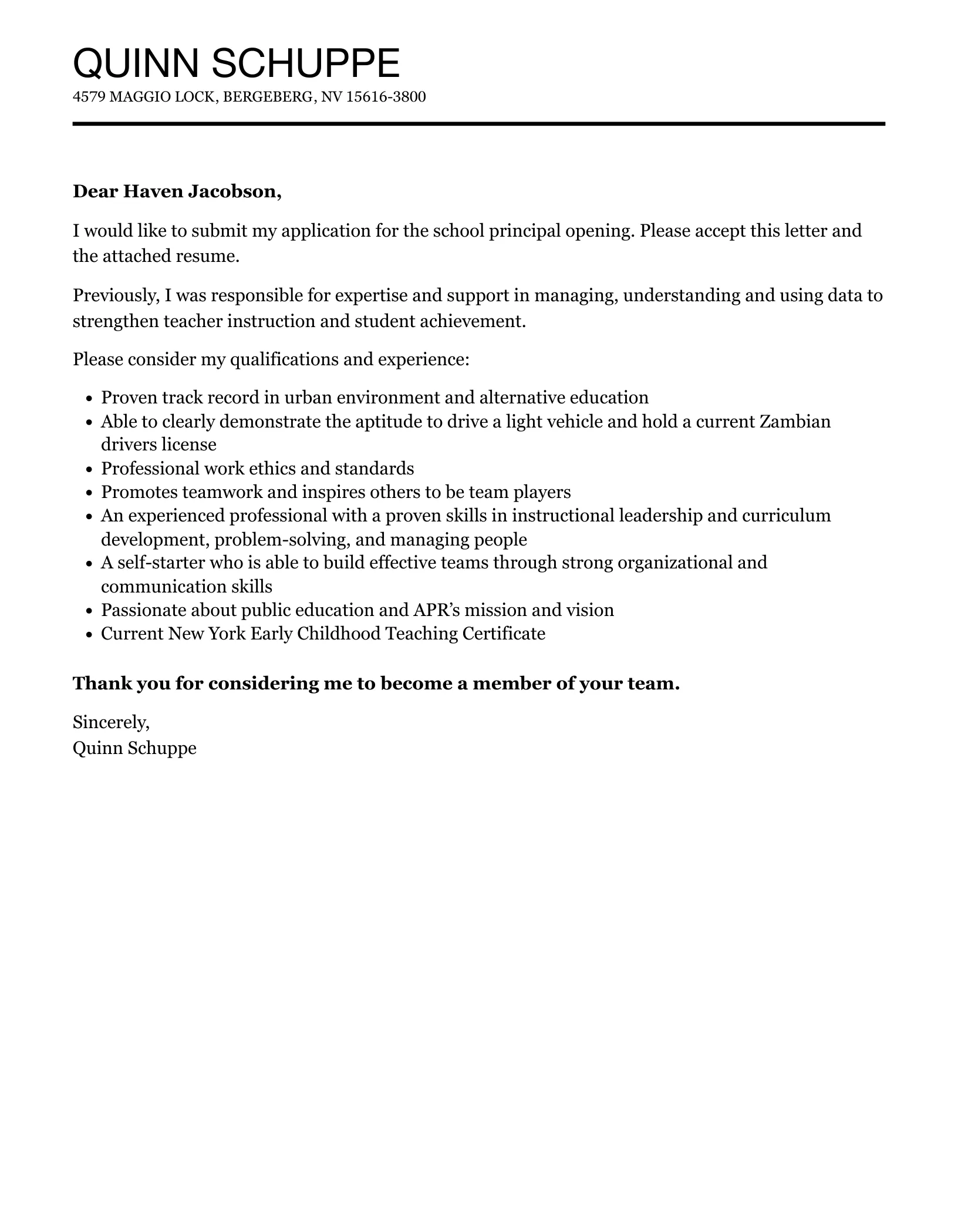
Your cover letter is the perfect place to showcase your educational leadership experience. This is your chance to shine. Describe your past roles, focusing on the leadership responsibilities you held and the impact you made. Did you mentor teachers, develop curriculum, or manage budgets? Provide specific examples of how you have led and inspired others, implemented new initiatives, or improved school performance. If you have experience in strategic planning, highlight your involvement in developing and executing school-wide goals. If you’ve played a role in improving test scores, reducing dropout rates, or enhancing school culture, make sure to mention it. Showcasing a strong leadership background can differentiate you from other candidates and highlight your readiness to take on the responsibilities of a school principal.
Quantifying Achievements in Your Cover Letter
Instead of simply stating what you have done, quantify your achievements whenever possible. This makes your accomplishments more concrete and impressive. For example, instead of saying “Improved student test scores,” say “Increased student test scores by 15% within one year.” Use numbers, statistics, and data to illustrate the impact of your work. This could include the number of programs you implemented, the amount of funding you secured, or the percentage increase in student attendance. When describing your successes, focus on outcomes rather than just the activities you undertook. This approach clearly demonstrates your ability to deliver results and contribute to the school’s success. The more data you can include in your letter, the more appealing you become.
Demonstrating Alignment with School Values
Principals want to hire candidates whose values align with their school’s mission and culture. Before writing your cover letter, research the school’s values, mission statement, and any specific initiatives they are focused on. Then, in your cover letter, demonstrate how your values and experiences align with theirs. Provide specific examples of how you have demonstrated these values in your previous roles. If the school emphasizes collaboration, describe how you have worked effectively with teachers, parents, and the community to achieve common goals. If the school values innovation, share examples of how you have implemented creative solutions to improve student outcomes. Tailoring your letter to reflect the school’s values will showcase your commitment to their success and increase your chances of getting an interview. This can be a major factor in landing the job.
Tailoring Your Cover Letter to the School
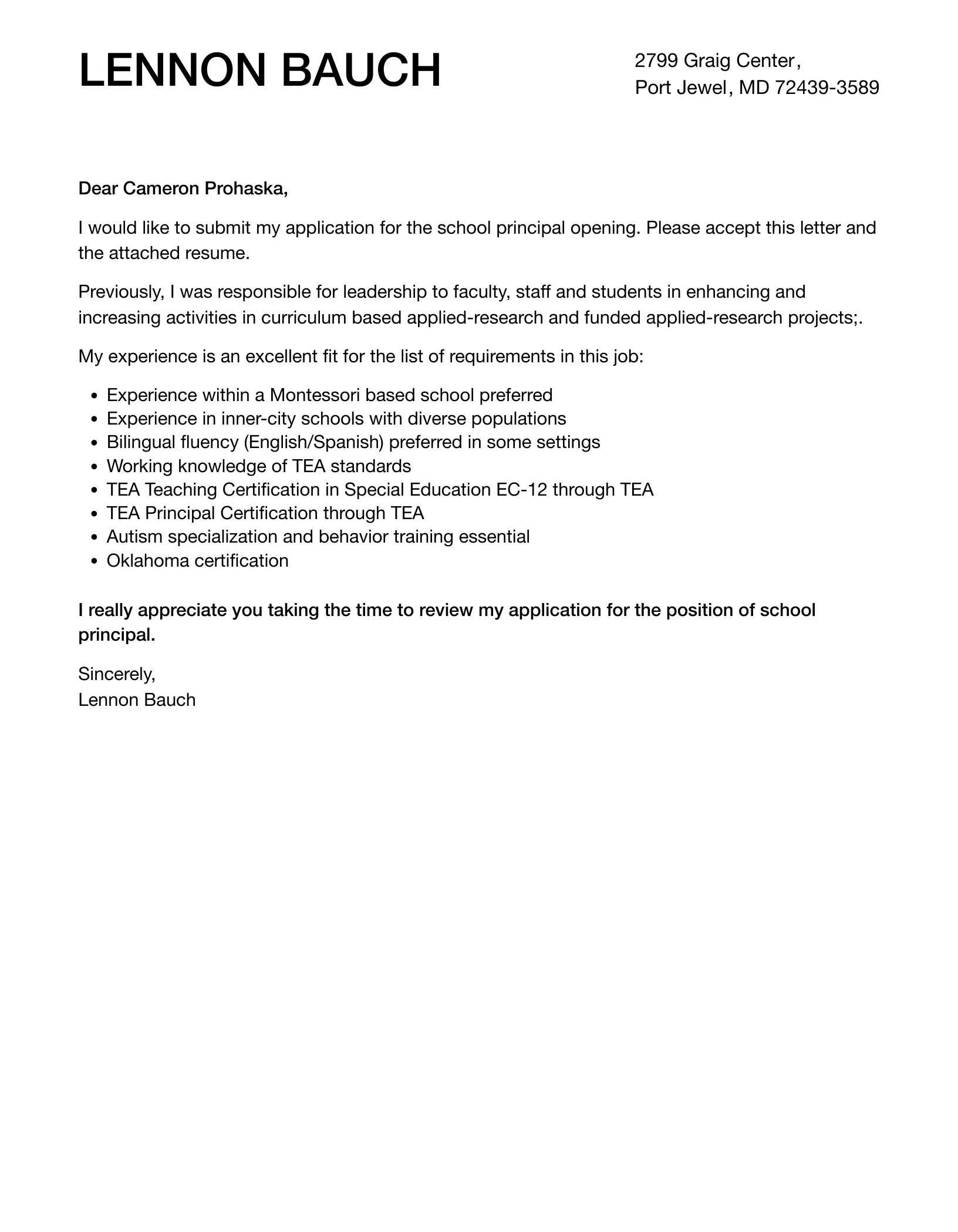
A generic cover letter will not impress a school principal. Tailor each cover letter to the specific school and position you are applying for. Show that you have done your research and understand the school’s unique needs and challenges. Address the principal by name, if possible, and reference specific programs, initiatives, or goals mentioned in the job description or on the school’s website. Highlight the aspects of your experience and skills that are most relevant to the school’s priorities. Explain why you are particularly interested in that school and what you hope to contribute to its success. By personalizing your cover letter, you demonstrate your genuine interest and show that you are not simply sending out a mass application. This level of attention to detail is crucial for making a positive impression.
Researching the School and Principal
Thoroughly research the school and the principal before writing your cover letter. Visit the school’s website to learn about its mission, values, programs, and recent accomplishments. Look for information about the principal, such as their background, leadership style, and any specific areas of focus. If possible, read news articles or social media posts about the school to gain a better understanding of its culture and community. This research will not only help you tailor your cover letter but also allow you to ask informed questions during the interview. Mentioning specific details about the school in your letter demonstrates your genuine interest and initiative. Demonstrate you are proactive and interested in working with the school and its staff.
Addressing the Principal Directly
Always address the principal by name in your cover letter. This shows that you have taken the time to research the school and personalize your application. If the principal’s name is not listed in the job posting, take the time to find it. Check the school’s website, the district’s website, or use LinkedIn to find the principal’s name. Using the principal’s name creates a more personal connection and makes your letter more engaging. If you are unsure of the principal’s gender, use a gender-neutral salutation, such as “Dear [Principal’s Last Name].” Avoid using generic greetings like “To Whom It May Concern,” as they make your letter feel impersonal.
Formatting and Structure of Your Cover Letter
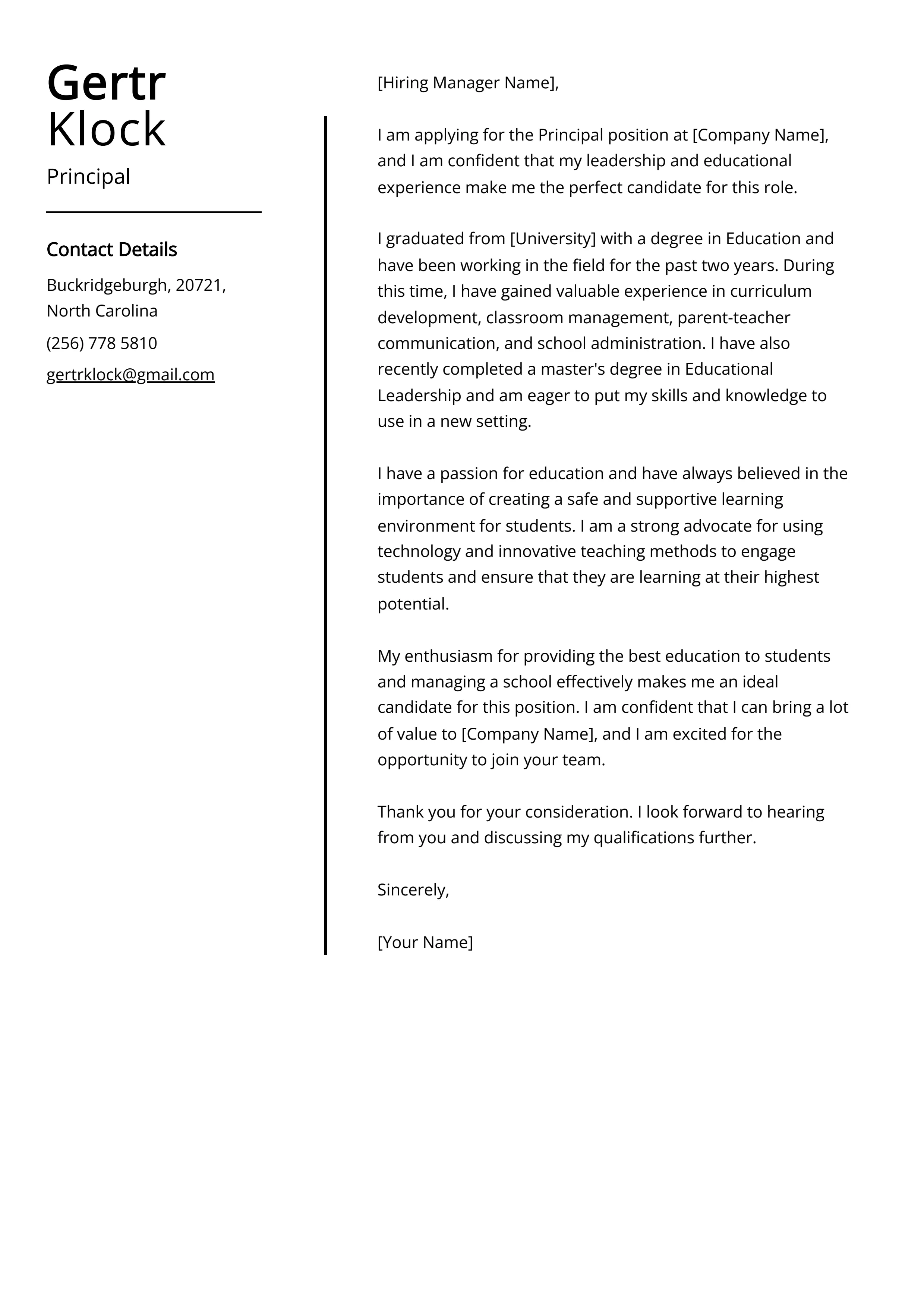
A well-formatted cover letter is easy to read and visually appealing. Use a professional font, such as Times New Roman, Arial, or Calibri, and maintain consistent font sizes throughout the document. Use standard margins (1 inch) and single-space your text, with a double space between paragraphs. Keep your letter concise and avoid long blocks of text. Break up your content into clear paragraphs with headings that make it easy for the principal to quickly scan the document. Ensure your letter is well-organized, with a clear introduction, body paragraphs, and conclusion. A clean, well-structured cover letter demonstrates your attention to detail and professionalism.
Professional Formatting for Impact
Professional formatting is essential for making a positive impression. Use a clear and readable font, such as Times New Roman, Arial, or Calibri. Maintain a consistent font size (typically 11 or 12 points) throughout the letter. Use standard margins (1 inch) and single-space the text, with a double space between paragraphs. Ensure your letter is free of any formatting inconsistencies, such as different indentations or inconsistent spacing. Proofread your letter carefully to ensure there are no typos or grammatical errors. A polished and well-formatted cover letter reflects your professionalism and attention to detail, helping you stand out from the competition.
Structuring Your Cover Letter Effectively
Structure your cover letter with a clear and logical flow. Start with a compelling introduction that grabs the principal’s attention and states the position you are applying for. In the body paragraphs, highlight your key skills, experiences, and achievements, providing specific examples to support your claims. Tailor your content to the specific school and demonstrate your understanding of their needs and goals. Use clear headings to guide the reader and make it easy to scan the document. End with a strong closing paragraph that summarizes your interest in the position and expresses your enthusiasm for an interview. A well-structured cover letter makes a positive impact and showcases your ability to communicate effectively.
Essential Content for Your Cover Letter
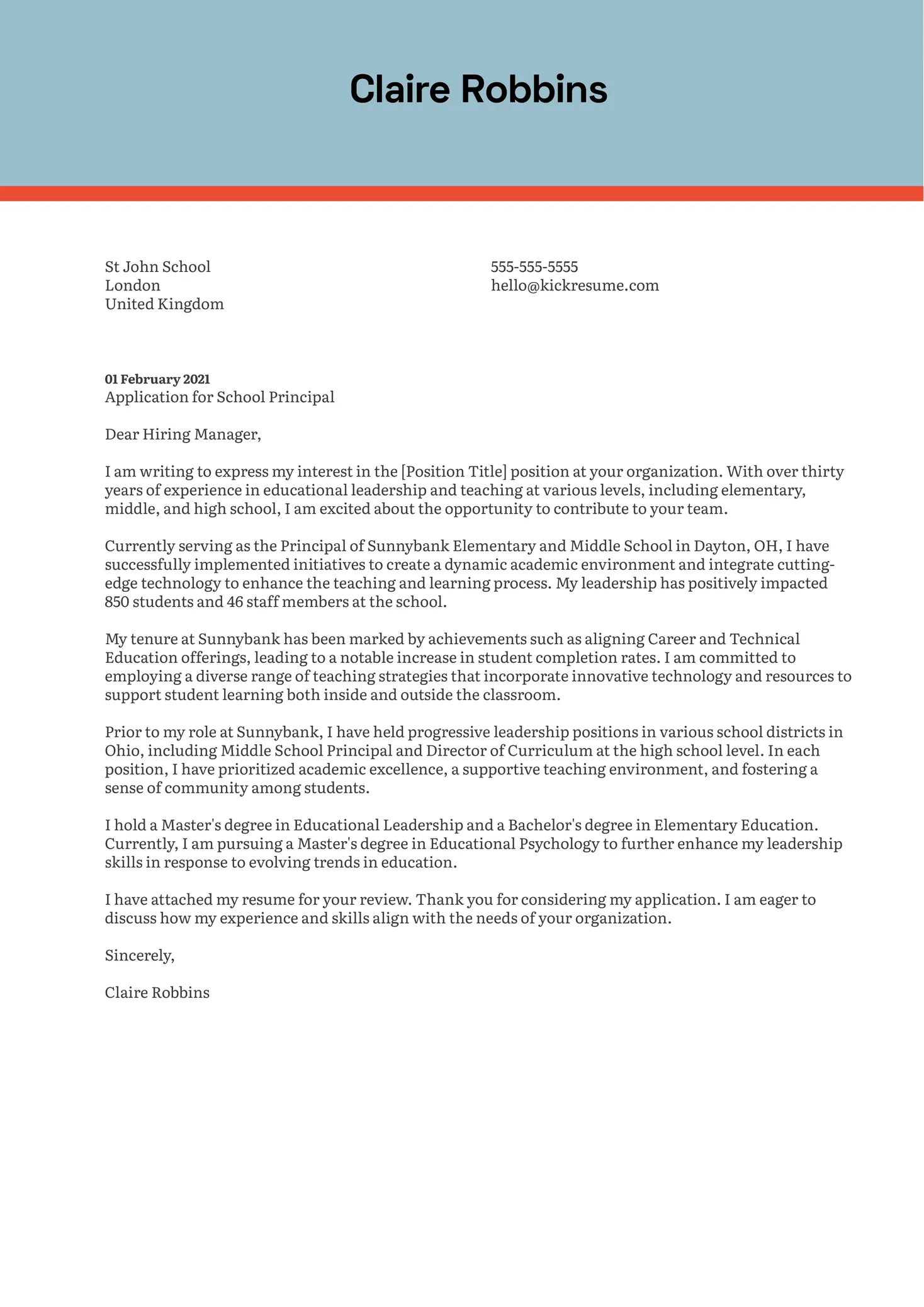
Your cover letter should include the following essential elements. Begin with your contact information and the date. Address the principal by name. In the opening paragraph, state the position you are applying for and where you saw the job posting. In the body paragraphs, highlight your key skills, experiences, and achievements. Tailor your content to match the requirements of the job and the needs of the school. Provide specific examples to support your claims and quantify your achievements whenever possible. In the closing paragraph, reiterate your interest in the position, express your enthusiasm for an interview, and thank the principal for their time and consideration. A well-rounded cover letter provides the principal with the relevant details they are looking for.
Opening Paragraph That Grabs Attention
The opening paragraph is your chance to make a strong first impression. Begin with a statement that immediately grabs the principal’s attention. State the position you are applying for and where you saw the job posting. Briefly mention your most relevant qualifications and what excites you about the opportunity. Avoid generic openings, such as “I am writing to express my interest.” Instead, try a more compelling approach. For example, if you have been following the school’s work, you could say, “Having followed [School Name]’s innovative approach to [specific program], I am eager to apply for the Principal position.” A strong opening sets the tone for the rest of your letter and encourages the principal to continue reading.
Body Paragraphs Highlighting Achievements
The body paragraphs are where you showcase your achievements and demonstrate your value as a potential principal. Focus on your most relevant skills, experiences, and accomplishments. Use specific examples to support your claims and quantify your achievements whenever possible. For example, instead of saying “Improved student engagement,” say “Increased student engagement by 20% through the implementation of a new school-wide initiative.” Highlight your successes in areas such as leadership, curriculum development, staff management, and community relations. Tailor your content to align with the school’s priorities and the requirements of the job description. The more evidence you can provide, the better your chances are of getting an interview.
Closing Paragraph for a Strong Finish
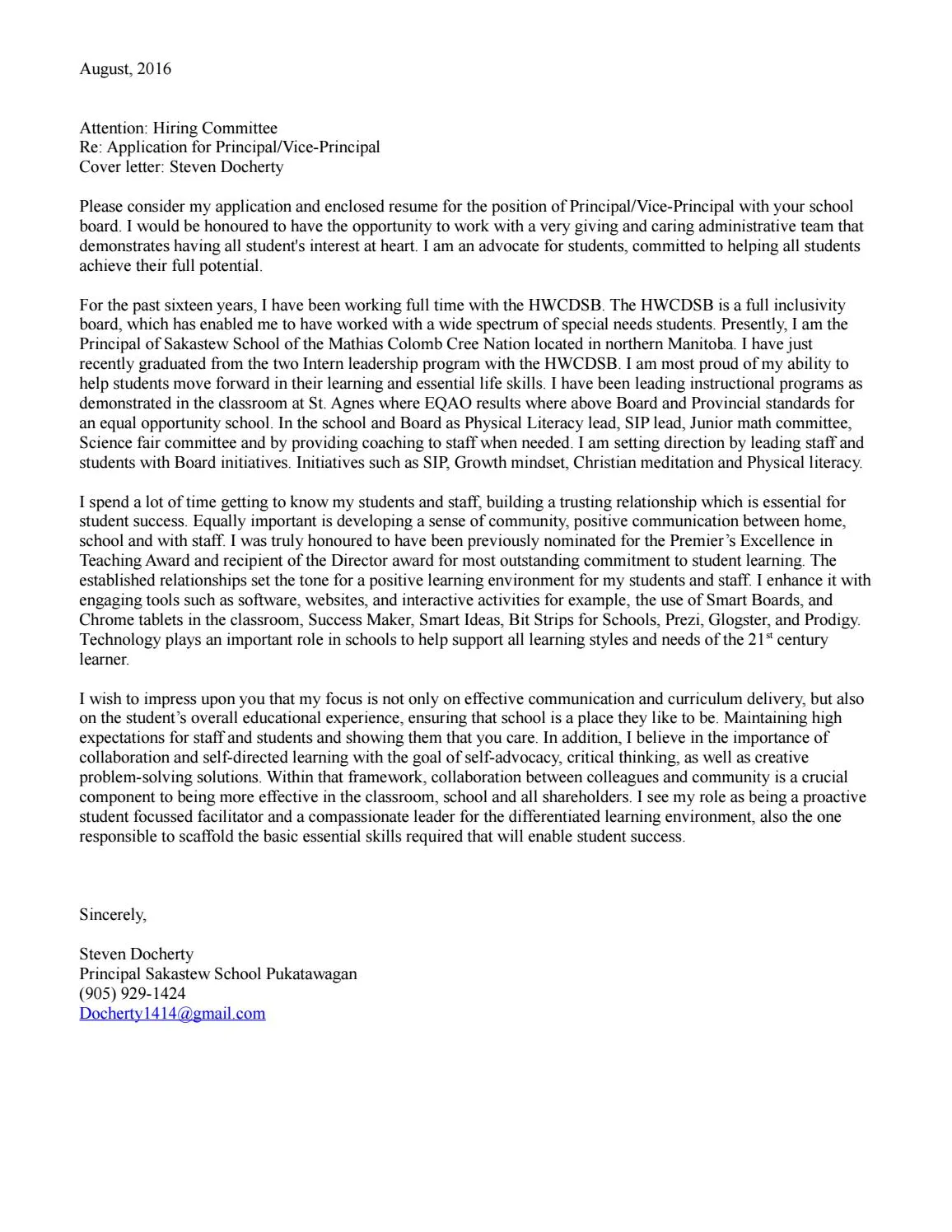
The closing paragraph should summarize your interest in the position and express your enthusiasm for an interview. Reiterate your key qualifications and how they align with the school’s needs. Thank the principal for their time and consideration. Clearly state your availability for an interview and provide your contact information again. Avoid generic closing statements and instead express genuine excitement about the opportunity. For example, you could say, “I am excited about the opportunity to contribute to [School Name]’s continued success and would welcome the chance to discuss my qualifications further in an interview.” A strong closing paragraph reinforces your interest and leaves a lasting positive impression.
Proofreading and Editing Your Cover Letter
Proofreading and editing your cover letter is crucial for ensuring it is free of errors and presents you in the best possible light. Carefully review your letter for any typos, grammatical errors, or formatting inconsistencies. Check the spelling of the principal’s name and the school’s name. Read your letter aloud to catch any awkward phrasing or unclear sentences. Ask a friend or colleague to review your letter and provide feedback. They can often catch mistakes that you might miss. A well-proofread and edited cover letter demonstrates your attention to detail and professionalism, increasing your chances of making a positive impression. Take your time and review it more than once.
Common Mistakes to Avoid
Avoid these common mistakes to ensure your cover letter makes a positive impact. Do not use generic language or clichés. Tailor your letter to the specific school and position. Avoid simply restating your resume. Use the cover letter to provide more details and demonstrate your personality. Do not include irrelevant information. Focus on your skills, experiences, and achievements that are relevant to the job. Avoid typos, grammatical errors, and formatting inconsistencies. Proofread carefully and have someone else review your letter. Avoid being overly formal or informal. Aim for a professional and engaging tone. By avoiding these common pitfalls, you can increase your chances of getting an interview.
Ensuring Clarity and Conciseness
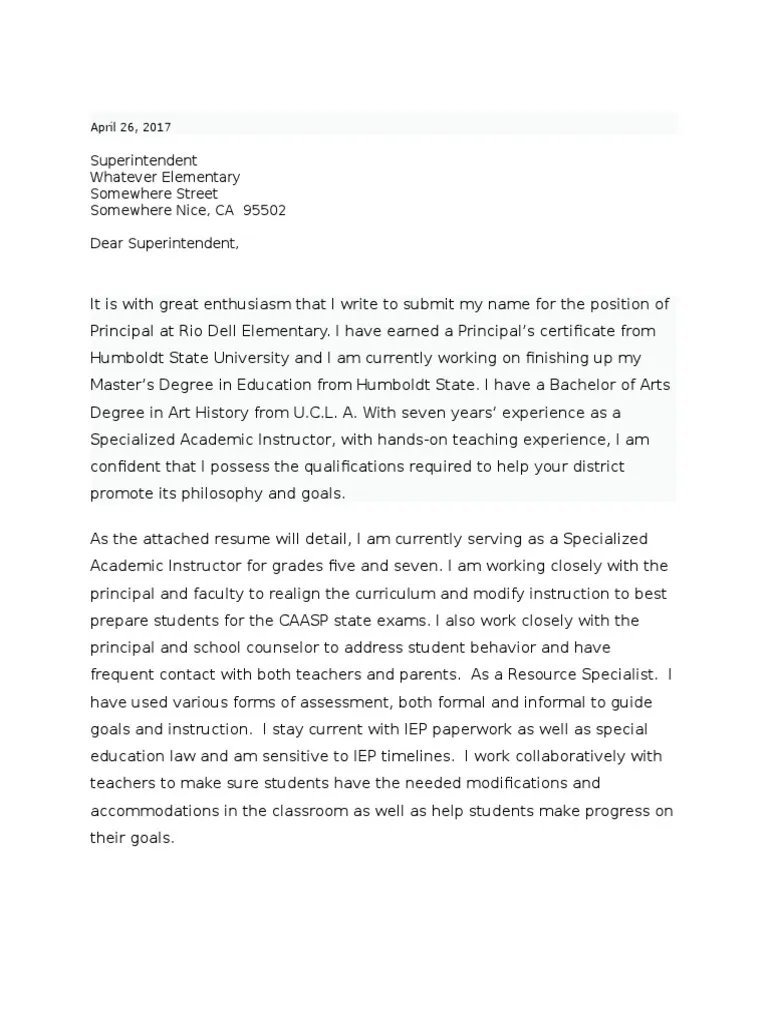
Clarity and conciseness are essential for a successful cover letter. Use clear and straightforward language. Avoid jargon or overly complex sentences. Keep your paragraphs short and focused on one main idea. Use strong action verbs to convey your achievements and skills. Organize your thoughts logically, with a clear introduction, body paragraphs, and conclusion. Eliminate any unnecessary words or phrases. Your cover letter should be easy to read and understand. The principal should be able to quickly grasp your qualifications and how they align with the school’s needs. A well-written and concise cover letter demonstrates your ability to communicate effectively.
Action Verbs to Enhance Your Cover Letter
Use strong action verbs to make your cover letter more impactful and engaging. Action verbs help you highlight your achievements and showcase your skills. Instead of saying “Responsible for,” use verbs such as “Managed,” “Led,” “Developed,” “Implemented,” or “Achieved.” For example, instead of saying “Was responsible for improving student test scores,” you could say “Improved student test scores by 15% through the implementation of a new curriculum.” Choose action verbs that accurately reflect your accomplishments. Review your cover letter and replace passive verbs with active ones to create a more dynamic and compelling document. Using dynamic action verbs is one of the best ways to make your letter stand out and grab attention.
Building Your Cover Letter With Examples
One of the best ways to create a strong cover letter is by providing specific examples that demonstrate your skills and experience. Use the STAR method (Situation, Task, Action, Result) to structure your examples. Describe the situation, the task you faced, the actions you took, and the results you achieved. For instance, if you want to showcase your leadership skills, you might describe a situation where you led a team to implement a new initiative. Outline the task, the actions you took to overcome challenges, and the positive results. By providing these examples, you make your cover letter more credible and memorable. Showing what you have done can make a bigger impact than simply saying you can do it.
Using Examples of Leadership
When showcasing your leadership skills, provide specific examples of how you have led and inspired others. Describe situations where you have taken initiative, motivated a team, or resolved conflicts. Highlight your ability to build consensus, make decisions, and delegate responsibilities effectively. For example, you might describe how you led a team to develop a new school-wide program or how you successfully mentored new teachers. Focus on the positive outcomes of your leadership, such as increased student achievement, improved staff morale, or enhanced school culture. Back up your claims with data and quantifiable results whenever possible. Examples of leadership are critical to a successful cover letter.
Showcasing Examples of Problem-Solving
School principals often face complex challenges. Your cover letter should showcase your ability to solve problems effectively. Describe situations where you have identified a problem, analyzed the situation, and developed a solution. Highlight your ability to think critically, make decisions under pressure, and implement effective strategies. For example, you might describe how you addressed a decline in student attendance, improved school safety protocols, or resolved a conflict between staff members. Focus on the positive outcomes of your problem-solving efforts, such as improved student outcomes, enhanced school safety, or increased staff satisfaction. Problem-solving ability is a core requirement of the job.
Provide Examples of Team Work
Collaboration is essential in education. Showcasing your teamwork skills is critical in your cover letter. Provide specific examples of how you have worked effectively with others to achieve common goals. Describe situations where you have collaborated with teachers, parents, administrators, or community members to implement a new initiative, improve student outcomes, or enhance school culture. Highlight your ability to communicate effectively, build consensus, and resolve conflicts. For example, you might describe how you collaborated with a team to develop a new curriculum, implement a new school-wide policy, or organize a community event. Teamwork is critical, so you need to show it in your letter.
Example Cover Letters for Principals
Reviewing example cover letters can help you understand the structure, content, and language used in successful applications. Search online for examples of cover letters for school principals. Pay attention to how the writers highlight their skills, experiences, and achievements. Analyze the examples to understand how they tailor their content to the specific school and position. Use these examples as a guide to create your own cover letter, but remember to personalize it to reflect your unique qualifications and experiences. Avoid simply copying the examples. You can adapt them for your own needs, but it’s best to create a unique letter, showing you have taken the time to research the opportunity.
